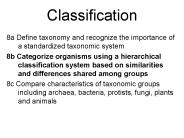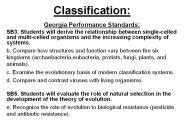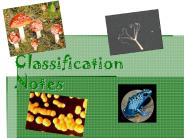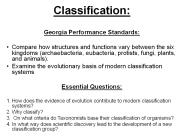Classification Of Organism PowerPoint PPT Presentations
All Time
Recommended
Biologists use a classification system to group organisms in part because organisms are going extinct. are very numerous and diverse. are too much alike.
| PowerPoint PPT presentation | free to download
Classification of Organisms Section 1: Categories of Biological Classification Section 2: How Biologists Classify Organisms Taxonomy Taxonomy is the science of naming ...
| PowerPoint PPT presentation | free to view
Classification of Organisms Biology- Chapter 18 (508-533) Modern Bio Chapter 17 (336-351) Biology Concepts and Connections Chap 15 (304-310) Web cd 15c
| PowerPoint PPT presentation | free to download
Classification of Organisms Classification of Organisms Taxonomy: branch of science dealing with the classification of organisms Purpose of classification ...
| PowerPoint PPT presentation | free to view
Classification of Organisms Chapter 16 Why is it important for organisms to be scientifically classified? 1. To avoid confusion that would result from only using ...
| PowerPoint PPT presentation | free to view
MCB 2010L Organism Classification Domain Eukarya Kingdom Protista Subkingdom Protozoa Phylum Sarcomastigophora Phylum Apicomplexa Kingdom Fungi Division (Phylum ...
| PowerPoint PPT presentation | free to download
Classification of organisms Kingdoms: Eubacteria, Archaebacteria, Protist and Fungi The Papillomavirus is a DNA virus that causes warts. The Influenza virus causes ...
| PowerPoint PPT presentation | free to view
Understand why a classification system is important ... Andrew Leech. What is an Organism? An organism is generally referred to any living ...
| PowerPoint PPT presentation | free to view
Classification of Living Organisms Unit 7, Part 1 * * * * * * * * * * * * However, if a hunting cat is born with a variation of long claws, he may be more successful ...
| PowerPoint PPT presentation | free to download
The Classification of Living Organisms The Five Kingdoms The Five Kingdom Classification of Living Organisms It is generally agreed that all organisms belong to one ...
| PowerPoint PPT presentation | free to view
Classification of Organisms BIO 138 - Ch. 17 Ch. 17, section 1: Classification of Organisms -Taxonomy is the science of describing, naming, and classifying organisms ...
| PowerPoint PPT presentation | free to view
Classification of All Organisms Domain Bacteria Kingdom Eubacteria 1. 3.5 billion years ago 2. Prokaryote A cell with no nucleus or membrane-bound organelles 3.
| PowerPoint PPT presentation | free to view
Chapter 14 : Classification of Organisms Taxonomy is the science of naming and classifying organisms. In this chapter you will learn about the classification system ...
| PowerPoint PPT presentation | free to view
Classification Dewey Decimal Classification DDC Tables Table 1 Standard Subdivisions: Contains mnemonics for standard subdivisions Used to add facets to the class ...
| PowerPoint PPT presentation | free to download
Chapter 17 Classification of Organisms Section 1 - Biodiversity Biologists have named and classified almost 2 million species. They believe the total is much greater.
| PowerPoint PPT presentation | free to view
Use a simple classification key to identify an unknown organism. Use a simple classification key to identify an unknown organism. Key concepts/skills: Level 1: Define ...
| PowerPoint PPT presentation | free to view
IPC - International Patent Classification Classification Practice - What and Where to Classify (and Search)? IPC Section, World Intellectual Property Organization (WIPO)
| PowerPoint PPT presentation | free to download
Classification 8a Define taxonomy and recognize the importance of a standardized taxonomic system 8b Categorize organisms using a hierarchical classification system ...
| PowerPoint PPT presentation | free to download
CLASSIFICATION WHY DO WE CLASSIFY ORGANISMS? We classify organisms in order to study the diversity of life. Biologist use a classification system to name the organism ...
| PowerPoint PPT presentation | free to view
CLASSIFICATION Why do you think scientists like to put organisms into groups, like mammals or insects? WHAT IS CLASSIFICATION? Classification is the arrangement of ...
| PowerPoint PPT presentation | free to view
Classification grouping of different types of organisms based upon similarities in structure and evolutionary relationships
| PowerPoint PPT presentation | free to view
CLASSIFICATION Why Classification? * Study the diversity of life * Group and name organisms in a logical manner Taxonomy: science of classifying living and creating ...
| PowerPoint PPT presentation | free to download
Classification Chapter 9 Classification is the Arrangement of organisms into orderly groups based on their similarities Classifying living things makes it easier for ...
| PowerPoint PPT presentation | free to download
Classification I. Carl Linnaeus Classification System 1. Taxonomy the science of naming organisms and assigning them to groups a. Similar structural ...
| PowerPoint PPT presentation | free to view
Classification Biology I Kingdom Animalia All eukaryotic, multicellular, heterotrophic, motile (most) organisms Common Phyla: Porifera (sponges, corral) Cnidaria ...
| PowerPoint PPT presentation | free to view
Classification: Georgia Performance ... (archaebacteria,eubacteria, protists, fungi, plants, and animals). ... Compare and contrast viruses with living organisms. SB5.
| PowerPoint PPT presentation | free to download
... Organism is commonly called Not used in the scientific community Green Iguana Domestic Cat The New Evolutionary Classification Categories that ...
| PowerPoint PPT presentation | free to download
Classification MRS C GREN Living organisms are able to perform all of MRS C GREN and non ... Skin Texture A. smooth - Amphibian B. scaly - Reptile III ...
| PowerPoint PPT presentation | free to view
CLASSIFICATION & 6 KINGDOM NOTES Why classify organisms? To organize the diversity of life To help us know what we are talking about Ex. Brown animal beaver or bison?
| PowerPoint PPT presentation | free to view
Classification As more was learned about cell structure in organisms, bacteria were removed from the protist kingdom and fungi were taken out of the plant kingdom.
| PowerPoint PPT presentation | free to download
Classification Each person might divide these shells into different categories Scientists often group and name, or classify, organisms using certain guidelines
| PowerPoint PPT presentation | free to download
Classification ... Classification
| PowerPoint PPT presentation | free to view
Classification Chapter 18
| PowerPoint PPT presentation | free to view
Classification - Montgomery ISD ... Classification
| PowerPoint PPT presentation | free to view
Classification Chapter 18
| PowerPoint PPT presentation | free to view
Classification * M.Bregar (Dante C.S.S.)
| PowerPoint PPT presentation | free to download
Chapter 18 Classification - Mr. Ni o's Classes ... Classification
| PowerPoint PPT presentation | free to download
Chapter 1, Section 4 Classification Grouping of similar objects Brief History More than 2,000 years ago, Aristotle grouped organisms into plants and animals In late ...
| PowerPoint PPT presentation | free to view
Classification Go to Section: Kingdom Eubacteria Go to Section: E. coli Streptococcus Cell Type Prokaryote Number of Cells Unicellular Nutrition Autotroph or ...
| PowerPoint PPT presentation | free to view
Classification Outdoor (ISO 9223-9226) and indoor (ISO 11844) classification
| PowerPoint PPT presentation | free to view
Classification Grouping & Identifying Living Things This Powerpoint is hosted on www.worldofteaching.com Please visit for 100 s more free powerpoints
| PowerPoint PPT presentation | free to view
Classification I. Classification -the arrangement of things in groups of similar items. -scientists classify living things to describe what they are like and how they ...
| PowerPoint PPT presentation | free to view
Classification Pink- headings Blue Vocabulary Purple Important Stuff
| PowerPoint PPT presentation | free to view
Classification Chapter 18(M) Classification/Taxonomy Classification the grouping of objects for practical purposes. Ex: Taxonomy the identification, naming and ...
| PowerPoint PPT presentation | free to view
Classification Why? Biology Ch 18 * A tree of life based on derived characteristics jus an example no need to memorize! * You DO need to now how this works.
| PowerPoint PPT presentation | free to view
Classification Notes Classification is the arrangement of organisms into groups based on their similarities. Why do we bother to classify things?
| PowerPoint PPT presentation | free to view
Classification Sorting it all out
| PowerPoint PPT presentation | free to download
Butterfly has a red body. 2b Butterfly has a black body. Go to 3. 3a. Butterfly ... Gather suggestions. Finding Order in Diversity Why Classify Organisms??
| PowerPoint PPT presentation | free to view
Classification Notes Why do we classify? Classification puts organisms into groups by looking at characteristics (traits) they share. Taxonomy Classifying living ...
| PowerPoint PPT presentation | free to download
Classification Sorting it all out Why Classify? Classification is putting things into orderly groups based on similar characteristics. Allows us to figure how many ...
| PowerPoint PPT presentation | free to download
Chapter 18 Classification
| PowerPoint PPT presentation | free to view
Title: Chapter 18 Classification Author: Kelso Last modified by: Grapevine-Colleyville ISD Created Date: 4/21/2004 4:48:58 AM Document presentation format
| PowerPoint PPT presentation | free to view
Classification The organization of living things DOMAIN ARCHAEA DOMAIN EUKARYA Kingdoms Eubacteria Archaebacteria Protista Plantae Fungi Animalia DOMAIN BACTERIA
| PowerPoint PPT presentation | free to view
Classification: Georgia Performance Standards: Compare how structures and functions vary between the six kingdoms (archaebacteria, eubacteria, protists, fungi, plants ...
| PowerPoint PPT presentation | free to download
Classification: Georgia Performance Standards: Compare how structures and functions vary between the six kingdoms (archaebacteria, eubacteria, protists, fungi, plants ...
| PowerPoint PPT presentation | free to download
CLASSIFICATION * * * * * * * * What is Classification? The grouping of things according to similar characteristics Geologists classify rocks, soil, and fossils ...
| PowerPoint PPT presentation | free to view
























































